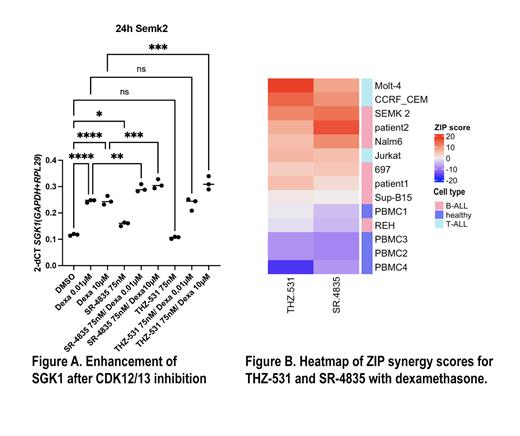Acute lymphoblastic leukemia (ALL) is an aggressive hematologic malignancy in children and young adults. Upfront resistance to glucocorticoids used as first-line treatment in most regimens confers a poor prognosis for patients with ALL. Of patients who relapse, only half achieve long-term survival. Here we demonstrate that inhibition of cyclin dependant kinases 12 and 13 (CDK12 & CDK13), which are modulators of RNA polymerase II, has a robust synergistic anti-leukemia effect with dexamethasone, in both B-ALL and T-ALL cell lines as well as primary B-ALL patient-derived bone marrow samples.
To understand the mechanism underlying the steroid resistance in ALL, we first reanalyzed shRNA screen performed by Poulard et al. This revealed that CDK13 silencing sensitized leukemic cells to dexamethasone. CDK12 is located on chromosome 17q12, containing oncogenic features and genetic alterations in various tumors. CDK12/13 inhibitor exhibits efficacy against an Ewing sarcoma tumor growth in a patient-derived xenograft mouse model. It was shown that the inhibition resensitizes HER2+ breast cancers to HER2-tyrosine kinase inhibitors via suppressing PI3K/AKT in patient-derived organoids in vitro and cell-derived xenograft or patient-derived xenograft in vivo. Forgoing research demonstrates that CDK12/13 inhibition silences transcription of DNA damage response (DDR) genes. In our study, however, we haven't observed a rise in γH2AX, a marker of DNA damage, after CDK12/13 inhibition in ALL cell lines. What we did note was a marked enhancement expression of BIM and SGK1, steroid responsive genes and pro-apoptotic factors, after CDK12/13 inhibition (Figure A).
ALL cell lines exhibited high susceptibility to CDK12/13 inhibition with two chemically divergent inhibitors, SR-4835 and THZ-531. We also showcased their synergistic interactions with dexamethasone using flow cytometry and synergyfinder ZIP score analysis (Figure B).
Moreover, in the GSEA comparison of ALL cell lines with and without synergy between CDK12/13 inhibitors and dexamethasone, our data underscored significant enrichment in cholesterol biosynthesis-related genesets in cell lines manifesting this synergistic effect. On the other hand, we observed resistance to SR-4835 in cell lines with high enrichment scores in NOTCH, a signaling pathway implicated in about 80% of relapsed T cell ALL/LBL cases. Additionally, new data on mice xenotransplanted with B-ALL CNS-derived patient cells, link upregulated cholesterol biosynthetic pathways to nervous system involvement in childhood ALL.
Upon administering CDK12/13 inhibitors, we observed a cell cycle phase shift resulting in G1 arrest and increased apoptosis, whereas human peripheral blood mononuclear cells (PBMCs) from healthy individuals remained unaffected by this treatment.
As we continue to decode the pathways through which CDK12/13 inhibitors render ALL cells more susceptible to dexamethasone, our next step includes silencing CDK12/13 using short hairpin RNA models in cell lines and consequently their RNA sequencing. This approach may mitigate the influence of secondary pathways, paving the way for enhanced treatment strategies for relapsed ALL by unmasking the underlying molecular events.
Disclosures
No relevant conflicts of interest to declare.


This feature is available to Subscribers Only
Sign In or Create an Account Close Modal